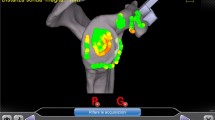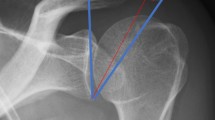Abstract
Purpose
We present a computer-assisted planning solution “ArthroPlanner” for acromioplasty based on 3D anatomical models, computed tomography and joint kinematic simulations.
Methods
In addition to a standard static clinical evaluation (anamnesis, radiological examination), the software provides a dynamic assessment of the shoulder joint by computing in real time the joint kinematics from a database of activities of daily living. During motion, the precise bone resection (location and amount) is computed based on detected subacromial impingements, providing surgeons with precise information about the surgical procedure. Moreover, to improve the subjective reading of medical images, the software provides 3D measurement tools based on anatomical models assisting in the analysis of shoulder morphological features.
Results
We performed an in vivo assessment of the software in a prospective randomized clinical study conducted with 27 patients beneficiating from the planning solution and a control group of 31 patients without planning. Postoperatively, patient’s pain decreased, and the shoulder range of motion and the functional outcomes improved significantly and the rotator cuff healing rate was good for both groups without intergroup differences. The amount of bone resected at surgery was comparable between the groups. The percentage of remaining impingement after surgery was in average reduced to 51% without groups difference.
Conclusions
ArthroPlanner software includes all required materials (images data, 3D models, motion, morphological measurements, etc.) to improve orthopedists’ performance in the surgical planning of acromioplasty. The solution offers a perfect analysis of the patient’s anatomy and the ability to precisely analyze a dynamic mechanism to fully apprehend the patient’s condition and to fulfill his/her expectations. The study however failed to detect any statistically significant difference in clinical outcomes and bone resection between the groups. Short-term clinical and radiological results were excellent in both groups.



Similar content being viewed by others
Notes
The incidence of acromioplasty has increased dramatically in recent decades. According to the American Board of Orthopaedic Surgery database, the mean number of arthroscopic acromioplasties reported per candidate increased from 2.6 to 6.3 between 1999 and 2008, a 142.3% increase, compared to 13.0% increase in the mean number of all orthopedic procedures [38, 43].
References
Barth J, Andrieu K, Fotiadis E, Hannink G, Barthelemy R, Saffarini M (2016) Critical period and risk factors for retear following arthroscopic repair of the rotator cuff. Knee Surg Sports Traumatol Arthrosc 25(7):2196–2204
Besl P, MacKay N (1992) A method for registration of 3-D shapes. IEEE Trans Pattern Anal Mach Intell 14(2):239–256
Bigliani L, Morrison D, April E (1986) The morphology of the acromion and its relationship to rotator cuff tears. Orthop Trans 10:228
Chahal J, Mall N, MacDonald P, Van Thiel G, Cole B, Romeo A, Verma N (2012) The role of subacromial decompression in patients undergoing arthroscopic repair of full-thickness tears of the rotator cuff: a systematic review and meta-analysis. Arthroscopy 28(5):720–727
Charbonnier C, Chagué S, Kolo FC, Chow JCK, Lädermann A (2014) A patient-specific measurement technique to model the kinematics of the glenohumeral joint. Orthop Traumatol Surg Res 100(7):715–719
Charbonnier C, Chagué S, Kolo FC, Lädermann A (2015) Shoulder motion during tennis serve: dynamic and radiological evaluation based on motion capture and magnetic resonance imaging. Int J Comput Assit Radiol Surg 10(8):1289–1297
Charbonnier C, Lädermann A, Kevelham B, Chagué S, Hoffmeyer P, Holzer N (2018) Shoulder strengthening exercises adapted to specific shoulder pathologies can be selected using new simulation techniques: a pilot study. Int J Comput Assit Radiol Surg 13(2):321–330
Chopp J, Dickerson C (2012) Resolving the contributions of fatigue-induced migration and scapular reorientation on the subacromial space: an orthopaedic geometric simulation analysis. Hum Mov Sci 31:448–460
Collin P, Matsumura N, Lädermann A, Denard P, Walch G (2014) Relationship between massive chronic rotator cuff tear pattern and loss of active shoulder range of motion. J Shoulder Elb Surg 23(8):1195–1202
Collin P, Yoshida M, Delarue A, Lucas C, Jossaume T, Lädermann A (2015) Evaluating postoperative rotator cuff healing: prospective comparison of MRI and ultrasound. Orthop Traumatol Surg Res 101(6):S265–S268
Constant C, Murley A (1987) A clinical method of functional assessment of the shoulder. Clin Orthop Relat Res 214:160–164
Cunningham G, Lädermann A, Denard P, Kherad O, Burkhart S (2015) Correlation between American shoulder and elbow surgeons and single assessment numerical evaluation score after rotator cuff or SLAP repair. Arthroscopy 31(9):1688–1692
Denard P, Lädermann A, Burkhart S (2011) Prevention and management of stiffness after arthroscopic rotator cuff repair: systematic review and implications for rotator cuff healing. Arthroscopy 27(6):842–848
Fagelman M, Sartori M, Freedman K, Patwardhan A, Carandang G, Marra G (2007) Biomechanics of coracoacromial arch modification. J Shoulder Elb Surg 16(1):101–106
Familiari F, Gonzalez-Zapata A, Ianno B, Galasso O, Gasparini G, McFarland E (2014) Is acromioplasty necessary in the setting of full-thickness rotator cuff tears? A systematic review. J Orthop Traumatol 16(3):167–174
Frank J, Chahal J, Frank R, Cole B, Verma N, Romeo A (2014) The role of acromioplasty for rotator cuff problems. Orthop Clin N Am 45(2):219–224
Gerber C, Catanzaro S, Betz M, Ernstbrunner L (2017) Arthroscopic correction of the critical shoulder angle through lateral acromioplasty: a safe adjunct to rotator cuff repair. Arthroscopy. https://doi.org/10.1016/j.arthro.2017.08.255
Goutallier D, Postel J, Bernageau J, Lavau L, Voisin M (2016) Fatty muscle degeneration in cuff ruptures. Pre- and postoperative evaluation by CT scan. Clin Orthop Relat Res 304:78–83
Graichen H, Hinterwimmer S, Eisenhart-Rothe R, Vogl T, Englmeier KH, Eckstein F (2005) Effect of abducting and adducting muscle activity on glenohumeral translation, scapular kinematics and subacromial space width in vivo. J Biomech 38(4):755–760
Katthagen J, Marchetti D, Tahal D, Turnbull T, Millett P (2016) The effects of arthroscopic lateral acromioplasty on the critical shoulder angle and the anterolateral deltoid origin: an anatomic cadaveric study. Arthroscopy 32(4):569–575
Koester M, George M, Kuhn J (2005) Shoulder impingement syndrome. Am J Med 118(5):452–455
Krekel P, de Bruin P, Valstar E, Post F, Rozing P, Botha C (2009) Evaluation of bone impingement prediction in pre-operative planning for shoulder arthroplasty. J Eng Med 223(7):813–822
Lädermann A, Denard P, Collin P (2015) Massive rotator cuff tears: definition and treatment. Int Orthop 39(12):2403–2414
Lee T, Black A, Tibone J, McMahon P (2001) Release of the coracoacromial ligament can lead to glenohumeral laxity: a biomechanical study. J Shoulder Elb Surg 10(1):68–72
Lippitt S, Harryman D, Matsen F (1993) A practical tool for function evaluation: the simple shoulder test. In: Matsen FAI, Fu FH, Hawkins RJ (eds) The shoulder: a balance of mobility and stability. American Academy of Orthopaedic Surgeons, Rosemont, pp 501–518
Maeseneer MD, Roy PV, Shahabpour M (2006) Normal MR imaging anatomy of the rotator cuff tendons, glenoid fossa, labrum, and ligaments of the shoulder. Radiol Clin N Am 44:479–487
Maurer A, Fucentese SF, Pfirrmann CWA, Wirth SH, Djahangiri A, Jost B, Gerber C (2012) Assessment of glenoid inclination on routine clinical radiographs and computed tomography examinations of the shoulder. J Shoulder Elb Surg 21(8):1096–1103
Michener L, McClure P, Karduna A (2003) Anatomical and biomechanical mechanisms of subacromial impingement syndrome. Clin Biomech 18(5):369–379
Moor B, Bouaicha S, Rothenfluh D, Sukthankar A, Gerber C (2013) Is there an association between the individual anatomy of the scapula and the development of rotator cuff tears or osteoarthritis of the glenohumeral joint? A radiological study of the critical shoulder angle. Bone Joint J 95B(7):935–941
Neer C (1972) Anterior acromioplasty for chronic impingement syndrome in the shoulder: a preliminary report. J Bone Joint Surg Am 54:41–50
Nyffeler R, Werner C, Sukthankar A, Schmid M, Gerber C (2006) Association of a large lateral extension of the acromion with rotator cuff tears. J Bone Joint Surg Am 88(4):800–805
Patte D (1990) Classification of rotator cuff lesions. Clin Orthop Relat Res 254:81–86
Richards R, An K, Bigliani L, Friedman R, Gartsman G, Gristina A, Iannotti J, Mow V, Sidles J, Zuckerman J (1994) A standardized method for the assessment of shoulder function. J Shoulder Elb Surg 3(6):347–352
Röling M, Visser M, Oei E, Pilot P, Kleinrensink G, Bloem R (2015) A quantitative non-invasive assessment of femoroacetabular impingement with CT-based dynamic simulation—cadaveric validation study. BMC Musculoskelet Disord 16(1):50
Romeo A, Loutzenheiser T, Rhee Y, Sidles J, Harryman D, Matsen F (1998) The humeroscapular motion interface. Clin Orthop Relat Res 350:120–127
Schmid J, Chênes C, Chagué S, Hoffmeyer P, Christofilopoulos P, Bernardoni M, Charbonnier C (2015) MyHip: supporting planning and surgical guidance for a better total hip arthroplasty: a pilot study. Int J Comput Assit Radiol Surg 10(10):1547–1556
Schneider P, Eberly D (2003) Geometric tools for computer graphics. The Morgan Kaufmann Series in Computer Graphics and Geometric Modeling. Morgan Kaufmann, San Francisco
Shi L, Edwards T (2012) The role of acromioplasty for management of rotator Cuff problems: where is the evidence? Adv Orthop 2012:467571
Song L, Miao L, Zhang P, Wang W (2016) Does concomitant acromioplasty facilitate arthroscopic repair of full-thickness rotator cuff tears? A meta-analysis with trial sequential analysis of randomized controlled trials. Springerplus 5(1):685
Spiegl U, Horan M, Smith S, Ho C, Millett P (2016) The critical shoulder angle is associated with rotator cuff tears and shoulder osteoarthritis and is better assessed with radiographs over MRI. Knee Surg Sports Traumatol Arthrosc 24(7):2244–2251
Su W, Budoff J, Luo Z (2009) The effect of coracoacromial ligament excision and acromioplasty on superior and anterosuperior glenohumeral stability. Arthroscopy 25(1):13–18
Timmons M, Lopes-Albers AD, Borgsmiller L, Zirker C, Ericksen J, Michener L (2013) Differences in scapular orientation, subacromial space and shoulder pain between the full can and empty can tests. Clin Biomech 28:395–401
Vitale M, Arons R, Hurwitz S, Ahmad C, Levine W (2010) The rising incidence of acromioplasty. J Bone Joint Surg 92(9):1842–1850
Voisin J, Ropars M, Thomazeau H (2014) The human acromion viewed from an evolutionary perspective. Orthop Traumatol Surg Res 100(8):S355–S360
Walch G, Vezeridis P, Boileau P, Deransart P, Chaoui J (2015) Three-dimensional planning and use of patient-specific guides improve glenoid component position: an in vitro study. J Shoulder Elbo Surg 24(2):302–309
Website (Accessed July 2017) PDF3D. https://www.pdf3d.com/
Website (Accessed July 2017) Qt. https://www.qt.io/
Website (Accessed July 2017) Visualization toolkit. http://www.vtk.org/
Wiley A (1991) Superior humeral dislocation. A complication following decompression and debridement for rotator cuff tears. Clin Orthop Relat Res 263:135–141
Wu G, van der Helm F, Veegerc H, Makhsouse M, Royf PV, Angling C, Nagelsh J, Kardunai A, McQuadej K, Wangk X, Wernerl F, Buchholzm B (2005) ISB recommendation on definitions of joint coordinate systems of various joints for the reporting of human joint motion—part II: shoulder, elbow, wrist and hand. J Biomech 38:981–992
Acknowledgements
This study was funded by Fondation Hans Wilsdorf, a nonprofit foundation with no commercial interest in the present study. We would like to thank Camille Laroquais for her help with the 3D reconstruction and postoperative analysis.
Author information
Authors and Affiliations
Corresponding author
Ethics declarations
Conflict of interest
The authors declare that they have no conflict of interest.
Research involving humans
Institutional ethical approval (CCER no. 15-151) was obtained prior to data collection, and the study was registered at ClinicalTrials.gov (NCT02725346). All procedures performed in the study were in accordance with the ethical standards of the institutional and/or national research committee and with the 1964 Helsinki declaration and its later amendments or comparable ethical standards.
Informed consent
Informed consent was obtained from all participants included in the study.
Rights and permissions
About this article
Cite this article
Charbonnier, C., Chagué, S., Kevelham, B. et al. ArthroPlanner: a surgical planning solution for acromioplasty. Int J CARS 13, 2009–2019 (2018). https://doi.org/10.1007/s11548-018-1707-9
Received:
Accepted:
Published:
Issue Date:
DOI: https://doi.org/10.1007/s11548-018-1707-9




